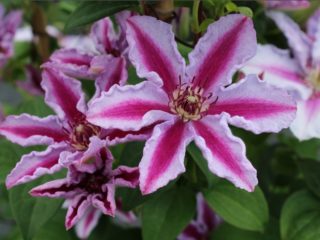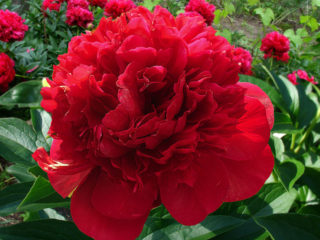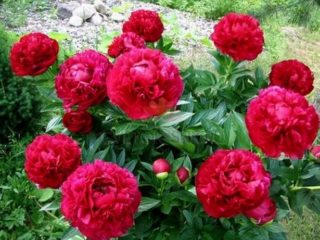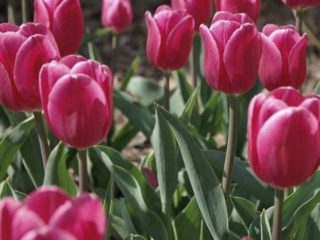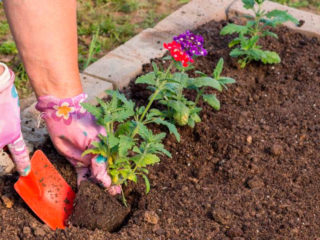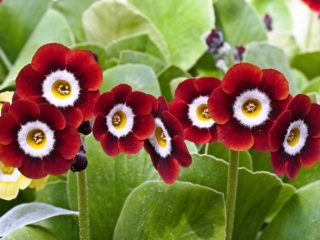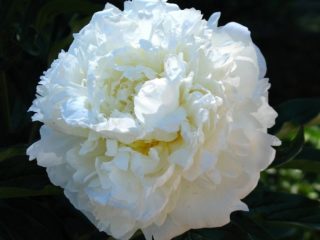Content
- 1 Description of Indian Duchesne
- 2 Is Indian Duchesnea edible?
- 3 The best varieties
- 4 Growing Indian Duchesnea from seeds at home
- 5 Planting Indian Duchesnea in open ground
- 6 Caring for the Indian Duchesnea
- 7 Diseases and pests
- 8 Reproduction methods
- 9 Photo of Indian Duchesnea in landscape design
- 10 Conclusion
- 11 Reviews from gardeners about Indian duchesne
As the photo and description of Indian Duchesnea show, it is a herbaceous groundcover perennial with decorative trifoliate leaves, small yellow flowers and bright red fruits. The plant, better known as cinquefoil or false strawberry, has antiseptic, antitumor and anti-inflammatory properties, thanks to which it is successfully used in oriental medicine.
Description of Indian Duchesne
Indian cinquefoil is a perennial from the Rosaceae family, discovered and described in the 9th century by the French botanist A. Duchesne. Southeast Asia is considered to be the birthplace of the plant.
Important! In the wild, Indian pseudostrawberry is found not only in India, but also in the USA, Japan, China and some regions of Southern Europe.
Externally, the Indian groundcover resembles an ordinary strawberry. It has the same basal rosettes, formed by trifoliate dark green leaves, and long shoots that stretch up to half a meter.

You can distinguish Indian duchesne from ordinary strawberries by flowers and fruits
The bright red round berries are directed upward and densely strewn with protruding seeds, and the petals are colored predominantly yellow.
False Indian strawberry is characterized by intense and long-lasting flowering. It starts in May and ends in mid-autumn. The Indian Duchesne flower develops singly and grows up to 15 mm in diameter. It consists of five petals surrounded by a large green cup.
Duchesnea is self-fertile and grows quietly even in the absence of pollinating insects. Most false berries ripen in June and July. A small part of the fruits ripen later, towards the end of autumn.
Is Indian Duchesnea edible?
False strawberry fruits can be consumed in small portions. When eaten in unlimited quantities, Duchenne berries cause illness. For allergy sufferers, the elderly, children, pregnant and lactating women, it is better to avoid eating cinquefoil fruits altogether.
The best varieties
Several varieties of the crop are now known, the most common of which are Tutti-Frutti and Rosita. Judging by the photos of variegated Duchesnea plants, each of them has individual characteristics that are best studied at the selection stage.
Duchesnea indica Tutti-Frutti
It is divided into canopy and ground cover varieties.The variety is characterized by high drought resistance and undemanding quality of soil, which greatly facilitates the process of growing Indian Duchesnea Tutti-Frutti.

Tutti-Frutti is easily propagated by tendrils and grows quickly, requiring frequent pruning
Duchesnea indica Rosita
A popular ground cover variety with upward-pointing berries, combined with green leaves that create the effect of summer freshness. Indian Duchesnea variety Rosita consistently bears fruit throughout the growing season and winters quietly without special shelter in the regions of the middle zone.

Duchesnea Rosita is resistant to trampling and grows equally well both in open ground and at home.
Growing Indian Duchesnea from seeds at home
False strawberry seeds remain viable for 2-3 years. Therefore, some summer residents prefer to propagate the plant in this way.
Sowing seeds
Duchenne seed material requires preliminary stratification. Preparation of seeds for planting begins at the end of January. They are wrapped in wet gauze or cellophane and sent to the refrigerator, in the vegetable compartment and kept there until spring, making sure that the wrapping material is constantly damp.
In March, stratified duchesne seeds are sown in wide boxes or closed plastic containers filled with a mixture of sand and peat. The crops are lightly sprinkled with substrate without deepening them. The ground is irrigated with water from a spray bottle and covered with polyethylene to retain moisture. Duchenee crops are ventilated daily and periodically watered.

With proper care, the first shoots of duchesne will appear in 1-6 weeks
Seedling care
Small and fragile seedlings of Indian Duchesnea are very difficult to pick.In order not to destroy young seedlings, experienced summer residents use special seedling cassettes with light nutritious soil, sowing 1-2 grains in them.
Duchesne seedlings are kept in diffused light and temperature +22-25 0C. The soil is sprayed with a spray bottle as the top layer dries. Stagnation of moisture is fraught with the development of rot, leading to the death of plants. When a pair of true leaves appear on the seedlings, they are dropped into individual cups.
Planting Indian Duchesnea in open ground
False strawberries are transplanted into unprotected soil in May, when the threat of return frosts has passed. For plants, choose a flat area, protected from drafts and scorching sun. Indian Duchesnea does not tolerate stagnant moisture and grows well in partial shade. It is better to plant it on hills under trees or large shrubs. The plant needs moderately fertile soil. When growing Indian duchesne in open ground enriched with nutrients, it expels multiple tendrils and builds up green mass to the detriment of flowering and fruiting. The looseness of the soil also matters. False strawberries take root best on loam and sandy loam soils.
For transplanting to the garden bed, select strong specimens of Duchesnea about 8 cm high with a well-developed rosette. Sluggish seedlings are grown at home, otherwise they will not survive. Such plants are transplanted into open ground in August, when the heat subsides, so that they have time to take root and adapt to new conditions before the onset of cold weather.
Caring for the Indian Duchesnea
Planting and caring for duchesne at home is not a troublesome task that can be easily handled by a novice plant grower. The main thing is to provide Indian pseudostrawberries with timely watering, fertilizing and pruning, as well as to properly prepare them for winter.
How often to water Duchesnea
When growing false strawberries in a flowerpot, provide regular watering. The soil under the plant is moistened as the top layer of soil dries. Timely watering is especially important at the stage of activation of vegetation processes and during the flowering period. With the onset of autumn, the plant gradually enters a state of winter dormancy, so the frequency of watering is reduced.

For irrigation use soft distilled or boiled, settled water at room temperature.
When growing Indian duchesne in a garden bed, there is usually enough natural precipitation. Additional watering may only be required during hot, dry periods.
Top dressing
Regardless of where Indian duchesne is grown, it requires fertilizers for proper development. False strawberries are alternately fed with organic matter and mineral compounds. In spring and summer, fertilizers are applied once a week. With the onset of autumn, they stop feeding the plants.
Preparing for winter
Indian Duchesnea, grown in pots, is transferred to a cool room for the winter. Plants planted in unprotected soil overwinter well under a layer of snow. If the winter is predicted to be snowless, the plantings are mulched with dry leaves and additionally covered with spruce branches.
Trimming
The fruits of Indian false strawberries are formed from withered inflorescences, therefore it is strictly forbidden to pick them. Berries that have darkened and lost their attractiveness are cut off along with the flowering stems. To maintain the decorative appearance of the plant, dried leaves are removed from it throughout the season. They are cut down to the very base.
Diseases and pests
If the growing conditions are not met, Indian Duchesnea becomes susceptible to certain diseases. False strawberries are susceptible to fusarium, phyllostictosis, anthracnose and powdery mildew. If signs of these diseases occur, plants are treated with fungicides (Ordan, Switch, Skor).

With the arrival of spring and the establishment of warmer weather, Duchesnei plantings are sprayed prophylactically
Of the harmful insects, the greatest danger to Indian false strawberries are slugs, beetles, Colorado potato beetles, spider mites and aphids. To combat them in the summer, insecticides are used. And to prevent the invasion of slugs, crushed eggshells are used.
Reproduction methods
False Indian strawberry is propagated by seeds and shoots. The first method is quite labor-intensive and requires preliminary preparation of the seed. Therefore, most gardeners prefer to propagate Indian duchesnea by shoots. The mustaches are rooted into the ground without separating them from the mother bush. For these purposes, choose the largest rosettes with healthy leaves. They are pressed to the surface of the soil and secured with wooden clothespins.

When the shoots produce roots, they are separated from the mother plant
To propagate the Indian duchesnea by the vegetative method, take root shoots with 3-4 nodes and, separating them from the original bush, plant them in a garden bed or in a low container until the roots become stronger.Divisions are performed in the first half of the year. The bushes are carefully removed from the ground, shaken off any adhering lumps of soil and cut into pieces, sprinkling the cut areas with crushed charcoal. The resulting cuttings are planted in individual pots.
Photo of Indian Duchesnea in landscape design
Landscapers use Indian false strawberries in two varieties: as a ground cover and an hanging crop. The plant looks equally impressive in both roles.

Duchesnea forms a dense and even carpet that hides bald spots and is appropriate in rocky areas
The ground cover is planted on the banks of reservoirs, along paths and under the crowns of large shrubs and trees.

The plant is suitable for decorating slopes and can be easily processed with a lawn mower.
Judging by the reviews, Indian Duchesnea looks organically in a flowerbed next to conifers. Successful neighbors for it are considered to be feathery carnation, loosestrife, ivy budra, alpine mountain weed, fragrant violet, sea lobularia and common thyme. In sunny areas, false strawberries are planted next to speckled jasmine, St. John's wort, stylized phlox, white sedum, rough cotula and evergreen iberis.

In partial shade, duchenea can be bred in the vicinity of tiarella cordifolia, European hooffoot and various types of tenacious

In a hanging design, false strawberries will decorate window sills, retaining walls, loggias and balconies
To increase decorative value, the crop is planted in flowerpots. In conditions of limited space and the inability to reproduce vegetatively, Indian Duchesnea produces many flowers and fruits that form both on the main plant and on the rosettes.Although false strawberry is considered a self-sufficient ampel crop, in container planting it is often combined with Wittrock violet and various types of hyacinths.
Conclusion
Photos and descriptions of Indian duchesne will help inexperienced gardeners distinguish it from real strawberries. Although these plants are very similar, they have several individual characteristics.
Reviews from gardeners about Indian duchesne
